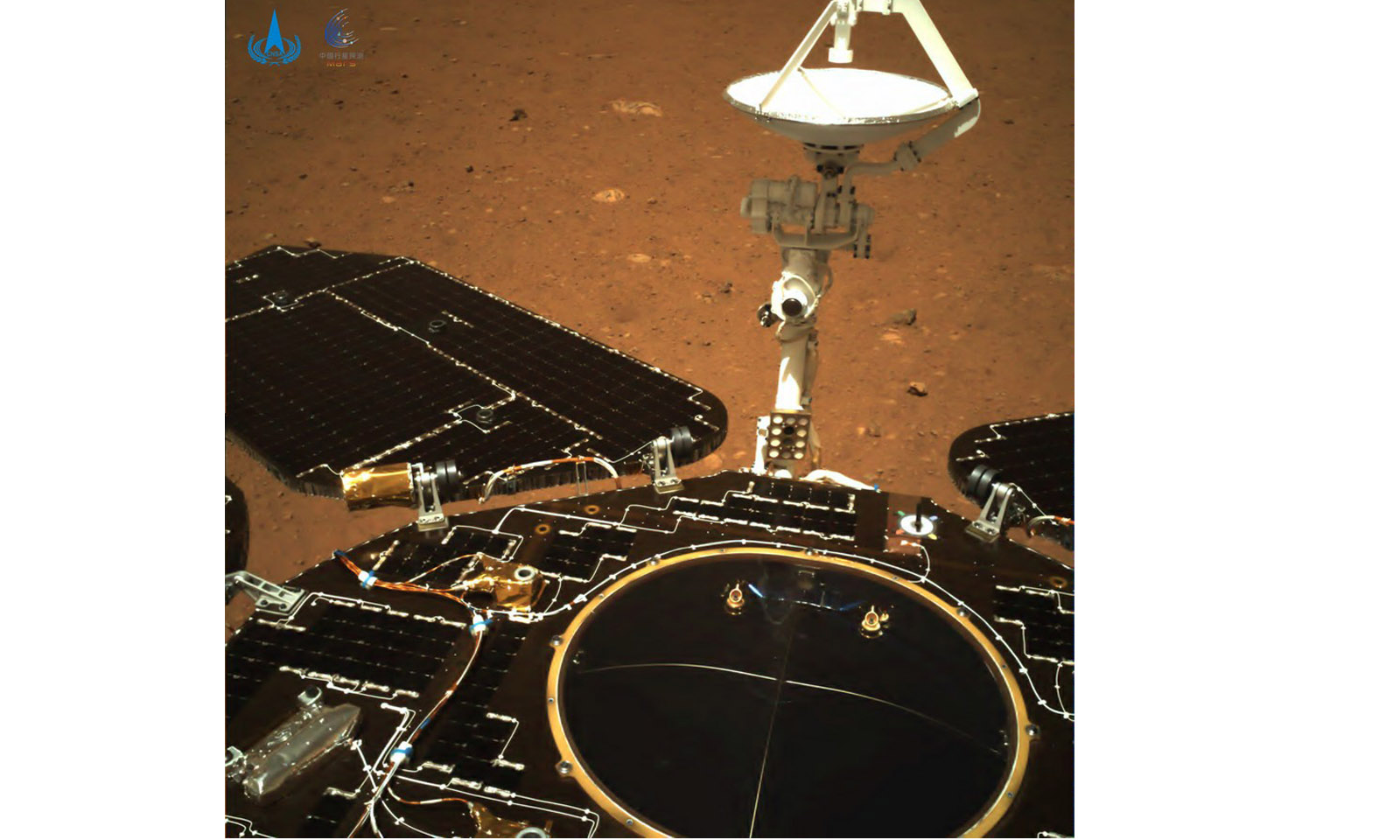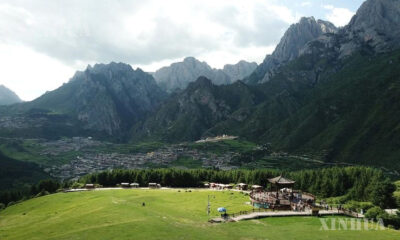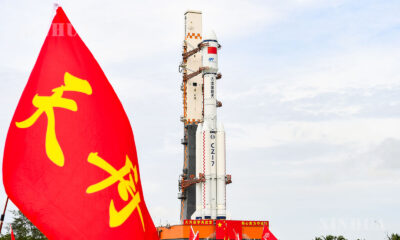China
တရုတ်နိုင်ငံ၏ ပထမဆုံး အင်္ဂါဂြိုဟ်ပေါ်သွားယာဥ် အင်္ဂါဂြိုဟ်မျက်နှာပြင်ပေါ်တွင် သွားလာမောင်းနှင်

ပေကျင်း၊ မေ ၂၂ ရက် (ဆင်ဟွာ)
တရုတ်နိုင်ငံ၏ ပထမဆုံး အင်္ဂါဂြိုဟ်ပေါ်သွားယာဉ် “ကျုလုံ”သည် ၎င်း၏ဂြိုဟ်ပေါ်ဆင်းသက်သည့်ပလက်ဖောင်းမှ အင်္ဂါဂြိုဟ်မျက်နှာပြင်ပေါ်သို့ မောင်းနှင်သွားလာနေပြီဖြစ်ကြောင်း တရုတ်နိုင်ငံ အမျိုးသားအာကာသစီမံခန့်ခွဲမှု ဦးစီးဌာန(CNSA)က စနေနေ့တွင် ကြေညာခဲ့သည်။
“ကျုလုံ”၏ ပထမဆုံး အောင်မြင်စွာ မောင်းနှင်သွားလာနိုင်မှုသည် တရုတ်နိုင်ငံကို အမေရိကန်ပြီးလျှင် အင်္ဂါဂြိုဟ်ပေါ်သို့ ဂြိုဟ်ပေါ်သွားယာဉ် ဆင်းသက်မောင်းနှင်နိုင်သည့် ဒုတိယမြောက်နိုင်ငံ ဖြစ်စေခဲ့သည်။
ရရှိသောအချက်အလက်များအရ “ကျုလုံ”သည် ပေကျင်းစံတော်ချိန် စနေနေ့ နံနက် ၁၀ နာရီ မိနစ် ၄၀ တွင် အင်္ဂါဂြိုဟ်မြေပြင်ပေါ်သို့ ဘီးချဆင်းသက်နိုင်ခြင်းဖြစ်ကြောင်း CNSAက ပြောသည်။
ဂြိုဟ်ပတ်လမ်းကြောင်းသွားယာဉ် (orbiter) ၊ ဂြိုဟ်ပေါ်ဆင်းသက်ယာဉ် (lander) နှင့် ဂြိုဟ်ပေါ်သွားယာဉ် (rover) တို့နှင့် ဖွဲ့စည်းထားသည် တရုတ်နိုင်ငံ၏ ထျန်းဝန်-၁ အာကာသယာဉ်ကို ၂၀၂၀ ပြည့်နှစ် ဇူလိုင် ၂၃ ရက်တွင် လွှတ်တင်ခဲ့ခြင်းဖြစ်သည်။ ဂြိုဟ်ပေါ်ဆင်းသက်ယာဉ်(lander)သည် ဂြိုဟ်ပေါ်သွားယာဉ် (rover)ကို သယ်ဆောင်ပြီး အင်္ဂါဂြိုဟ်မြောက်ဘက်ခြမ်း Utopia မြေပြန့်တောင်ပိုင်းကို မေ ၁၅ ရက်က ဆင်းသက်ခဲ့သည်။
ဘီး(၆)လုံးတပ်ဆင်ထားသည့် နေရောင်ခြည်စွမ်းအင်သုံး ဂြိုဟ်ပေါ်သွားယာဉ်(rover)သည် အပြာရောင်လိပ်ပြာနှင့်သဏ္ဍာန်တူပြီး အလေးချိန် (၂၄၀)ကီလိုဂရမ်ရှိသည်။ ၎င်းယာဉ်ကို တရုတ်ရှေးဒဏ္ဍာရီတွင်ပါရှိသည့် မီးနတ်မင်း၏ နာမည် “ကျုလုံ”ဟု အမည်ပေးထားရာ ဂြိုဟ်နီကြီး(အင်္ဂါဂြိုဟ်)၏ တရုတ်နာမည်နှင့်အလားတူပြီး အာကာသယာဉ် “ထျန်းဝန်”က ရှေးခေတ် တရုတ် ကဗျာဆရာကြီး ချွီးယွမ် (ဘီစီ ၃၄၀ – ဘီစီ ၂၇၈ ခန့်) ၏ ကဗျာအမည်ဖြစ်ရာ “ကောင်းကင်သို့ စူးစမ်းမေးမြန်းခြင်း”ဟု အနက်အဓိပ္ပါယ်ရကြောင်း သိရသည်။
“ကျုလုံ”၏သက်တမ်းသည် အနည်းဆုံး အင်္ဂါဂြိုဟ်၏ ရက် ၉၀ (ကမ္ဘာမြေ၏ (၃)လကြာခန့်)ရှိမည် ဖြစ်သည်။ ၎င်းသည် အင်္ဂါဂြိုဟ်ရှုခင်းများအား ရုပ်ထွက်မြင့်မားသည့် 3D ဓါတ်ပုံများဖြင့် မှတ်တမ်းတင်ခြင်း ၊ ဂြိုဟ်မျက်နှာပြင်၏ဖွဲ့စည်းပုံကို ခွဲခြမ်းစိတ်ဖြာနိုင်ခြင်း၊ မြေအောက်ဖွဲ့စည်းပုံနှင့် သံလိုက်စက်ကွင်းရှာဖွေခြင်း၊ ရေခဲရှာဖွေခြင်းနှင့် ပတ်ဝန်းကျင်မိုးလေဝသ အခြေအနေကို စူးစမ်းခြင်းတို့ကို ဆောင်ရွက်နိုင်မည်ဖြစ်ကြောင်း သိရသည်။
အင်္ဂါဂြိုဟ်ပေါ်သွားယာဉ် “ကျုလုံ”တွင် မြေပြင်အနေအထားရိုက်ကူးရေးကင်မရာ၊ ရောင်စဥ်မျိုးစုံရိုက်ကူးရေးကင်မရာ၊ မြေလွှာအောက်စူးစမ်းလေ့လာရေး ရေဒါ၊ မြေလွှာဖွဲ့စည်းပုံ ထောက်လှမ်းရေးကိရိယာ၊ သံလိုက်စက်ကွင်းထောက်လှမ်းရေးကိရိယာနှင့် မိုးလေဝသစောင့်ကြည့်လေ့လာရေး မော်နီတာတို့ ပါဝင်ကြောင်း သိရသည်။
ဂြိုဟ်ပတ်လမ်းကြောင်းသွားယာဉ် (orbiter) ၏ ဒီဇိုင်းသက်တမ်းသည် အင်္ဂါဂြိုဟ်၏ တစ်နှစ် (ကမ္ဘာဂြိုဟ်၏ ရက်ပေါင်း ၆၈၇ ရက်ခန့်)ဖြစ်သည်။ ၎င်းသည် ဂြိုဟ်ပေါ်သွားယာဉ် (rover)၏ အချိတ်အဆက်ဖြစ်သလို ကိုယ်တိုင်လည်း သိပ္ပံဆိုင်ရာ ရှာဖွေမှုများပြုလုပ်နိုင်ကြောင်း သိရသည်။ (Xinhua)
————————————
(English Version)
Update: China’s first Mars rover drives onto red planet’s surface
2021-05-22 14:14:36
BEIJING, May 22 (Xinhua) — China’s first Mars rover, Zhurong, has driven down from its landing platform to the Martian surface, the China National Space Administration (CNSA) announced on Saturday.
Zhurong’s first successful drive made China the second country after the United States to land and operate a rover on Mars.
According to the telemetry data, Zhurong set its wheels on Martian soil at 10:40 a.m. (Beijing Time) on Saturday, the CNSA said.
China’s Tianwen-1 mission, consisting of an orbiter, a lander and a rover, was launched on July 23, 2020. The lander carrying the rover touched down in the southern part of Utopia Planitia, a vast plain on the northern hemisphere of Mars, on May 15.
The six-wheeled solar-powered rover, resembling a blue butterfly and with a mass of 240 kg, is named after the god of fire in ancient Chinese mythology. The name echoes with the Chinese name for the red planet, Huoxing (the planet of fire), while the name of the mission, Tianwen, means Questions to Heaven, the title of a poem by the ancient Chinese poet Qu Yuan (circa 340-278 BC).
With an expected lifespan of at least 90 Martian days (about three months on Earth), Zhurong will record the Martian landscape with high-resolution three-dimensional images, analyze the material composition of the planet’s surface, detect its sub-surface structure and magnetic field, search for traces of water ice and observe the surrounding meteorological environment.
It carries various scientific instruments, including terrain camera, multi-spectral camera, sub-surface exploration radar, surface-composition detector, magnetic-field detector and meteorology monitor.
The orbiter, with a design life of one Martian year (about 687 days on Earth), will relay communications for the rover while conducting its own scientific detection operations. ■
Color photo released by the China National Space Administration (CNSA), taken by the navigation camera on the rover, shows that the rover’s solar panels and antenna are seen unfolded, and the red soil and rocks on the Martian surface are clearly visible in the image. (CNSA/Handout via Xinhua)






